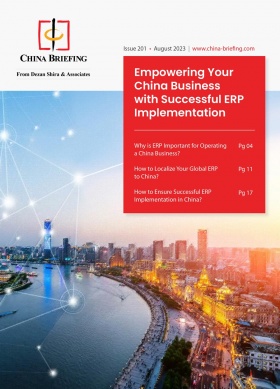China Announces New Additional VAT Deduction for Advanced Manufacturing Companies
China’s tax authorities have announced an additional 5 percent value-added tax (VAT) deduction for advanced manufacturing based on their deductible input VAT for the current tax period. Analysts have projected that the new policy could lead to a 20 percent reduction in tax burdens for eligible companies. We summarize the requirements and implementation procedures for this new China VAT policy.
On September 3, 2023, China’s State Tax Administration (STA) announced a new tax deduction for companies in the advanced manufacturing sector. The new policy will be implemented from January 1, 2023, until December 31, 2027.
The Deputy Director of the Institute of Public Policy and Governance of Shanghai University of Finance and Economics, Tian Zhiwei, told Yicai that the new policy is equivalent to reducing the VAT burden of eligible companies by about 20 percent.
In recent months, China’s tax authorities have expanded and extended a range of preferential tax policies for both companies and individuals in an effort to reduce the tax burden and stimulate economic growth. These include raising the standards of special additional deductions for Individual Income Tax (IIT), extending IIT benefits for foreigners until 2027, expanding the pre-tax super deduction for R&D expenses, and providing VAT exemptions for small-scale taxpayers.
Which companies are eligible for the additional China VAT deduction?
The new policy applies to companies that are certified as high and new technology enterprises (including their branch companies that are not legal entities), engaged in manufacturing, and registered as general taxpayers (taxpayers with annual taxable sales of over RMB 5 million or approx.US$680,827).
Note that China already provides a similar additional VAT deduction policy for companies in the service industry.
“High and new technology enterprises” are defined in accordance with the Administrative Measures for the Recognition of High-Tech Enterprises, released in 2016, as “Resident enterprises registered in China (excluding Hong Kong, Macao, and Taiwan) that carry out research and development and transform technological achievements to form the core independent intellectual property rights of the enterprise, and carry out business activities on this basis, within the list of High-tech Fields Supported by the State.”
The announcement states that the specific list of advanced manufacturing companies will be determined by the provincial, regional, or municipal industrial and information technology departments.
How is the additional deduction calculated?
In China, companies can enjoy deductions of certain types of input VAT against output VAT, for example, the VAT amount indicated on special VAT invoices obtained from suppliers, special tax payment receipts of customs import VAT obtained from the customs office, and so on.
General taxpayers calculate the VAT payable by deducting the input VAT in the current period from the output VAT in the current period.
Under the new policy, eligible companies can calculate the additional deduction amount as 5 percent of the deductible input VAT for the current period.
Input VAT that cannot be deducted from output VAT in accordance with current regulations cannot be considered for calculating the additional deduction amount. Any previously calculated additional deduction for input VAT that is transferred must be correspondingly reduced in the period when the input VAT is transferred.
After calculating the pre-deduction payable VAT, companies can apply the additional deduction as follows:
- If the pre-deduction payable VAT is zero, the entire additional deductible VAT (as opposed to standard deductibles) for the current period can be carried forward to the next period;
- If the pre-deduction payable VAT is greater than zero and exceeds the additional deductible VAT in the current period, then the entire additional deductible VAT for the current period can be deducted from the pre-deduction payable VAT; and
- If the pre-deduction payable VAT is greater than zero but less than or equal to the current period’s additional deductible VAT, then the current period’s additional deductible VAT is used to reduce the pre-deduction payable VAT to zero. Any remaining additional deductible VAT for the current period can be carried forward and deducted in the next period.
Companies can calculate and record any eligible but unrecorded additional deductible VAT in the same period when the applicable additional deduction policy is determined.
Note that the additional VAT deduction policy is not applicable to the export of goods and labor services or cross-border taxable activities carried out by a taxpayer.
For companies that are engaged in both the export of goods and services and cross-border taxable activities and for which input VAT cannot be calculated separately for additional deduction, the following formula should be used to calculate the input VAT not eligible for additional deduction:
Input VAT not eligible for additional deduction =
Total input VAT that cannot be separated for the current period ×
Sales revenue from export of goods and services and cross-border taxable activities for the current period ÷
Total sales revenue for the current period
Can this policy be applied together with other additional VAT deduction policies?
No, companies that qualify for multiple additional VAT deduction policies can choose to apply the one that is most favorable to them, but multiple policies cannot be applied simultaneously during the same period.
About Us
China Briefing is written and produced by Dezan Shira & Associates. The practice assists foreign investors into China and has done so since 1992 through offices in Beijing, Tianjin, Dalian, Qingdao, Shanghai, Hangzhou, Ningbo, Suzhou, Guangzhou, Dongguan, Zhongshan, Shenzhen, and Hong Kong. Please contact the firm for assistance in China at china@dezshira.com.
Dezan Shira & Associates has offices in Vietnam, Indonesia, Singapore, United States, Germany, Italy, India, and Russia, in addition to our trade research facilities along the Belt & Road Initiative. We also have partner firms assisting foreign investors in The Philippines, Malaysia, Thailand, Bangladesh.
- Previous Article 中国财税资讯月报:2023年8月
- Next Article China’s Proposed Measures to Ease Cross-Border Data Management for MNCs







